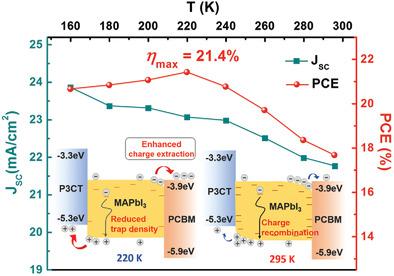当前位置:
X-MOL 学术
›
Adv. Funct. Mater.
›
论文详情
Our official English website, www.x-mol.net, welcomes your
feedback! (Note: you will need to create a separate account there.)
Understanding Temperature‐Dependent Charge Extraction and Trapping in Perovskite Solar Cells
Advanced Functional Materials ( IF 18.5 ) Pub Date : 2020-04-07 , DOI: 10.1002/adfm.202000550 Qian Zhou 1 , Boxing Wang 2 , Rui Meng 1 , Jiyu Zhou 1 , Shenkun Xie 2 , Xuning Zhang 1 , Jianqiu Wang 2 , Shengli Yue 2 , Bing Qin 3 , Huiqiong Zhou 2 , Yuan Zhang 1
Advanced Functional Materials ( IF 18.5 ) Pub Date : 2020-04-07 , DOI: 10.1002/adfm.202000550 Qian Zhou 1 , Boxing Wang 2 , Rui Meng 1 , Jiyu Zhou 1 , Shenkun Xie 2 , Xuning Zhang 1 , Jianqiu Wang 2 , Shengli Yue 2 , Bing Qin 3 , Huiqiong Zhou 2 , Yuan Zhang 1
Affiliation

|
Understanding the factors that limit the performance of perovskite solar cells (PSCs) can be enriched by detailed temperature (T )‐dependent studies. Based on p‐i‐n type PSCs with prototype methylammonium lead triiodide (MAPbI3) perovskite absorbers, T ‐dependent photovoltaic properties are explored and negative T ‐coefficients for the three device parameters (V OC, J SC, and FF) are observed within a wide low T ‐range, leading to a maximum power conversion efficiency (PCE) of 21.4% with an impressive fill factor (FF) approaching 82% at 220 K. These T ‐behaviors are explained by the enhanced interfacial charge transfer, reduced charge trapping with suppressed nonradiative recombination and narrowed optical bandgap at lower T . By comparing the T ‐dependent device behaviors based on MAPbI3 devices containing a PASP passivation layer, enhanced PCE at room temperature is observed but different tendencies showing attenuating T ‐dependencies of J SC and FF, which eventually leads to nearly T ‐invariable PCEs. These results indicate that charge extraction with the utilized all‐organic charge transporting layers is not a limiting factor for low‐T device operation, meanwhile the trap passivation layer of choice can play a role in the T ‐dependent photovoltaic properties and thus needs to be considered for PSCs operating in a temperature‐variable environment.
中文翻译:

了解钙钛矿太阳能电池中与温度有关的电荷提取和俘获
可以通过详细的温度(T)依赖研究来丰富了解限制钙钛矿太阳能电池(PSC)性能的因素。基于具有原型甲基铵三碘化铅(MAPbI 3)钙钛矿吸收剂的p-i-n型PSC ,研究了T依赖的光伏性能,并观察到三个器件参数(V OC,J SC和FF)的负T系数在一个很低的T范围内,导致最大功率转换效率(PCE)为21.4%,而在220 K时,令人印象深刻的填充因数(FF)接近82%。这些T行为可以通过增强的界面电荷转移,减少的电荷俘获和抑制的非辐射重组以及在较低的T处的光学带隙变窄来解释。通过比较基于含PASP钝化层的MAPbI 3器件的T依赖性器件行为,可以观察到室温下PCE增强,但是不同的趋势显示J SC和FF的T依赖性减弱,最终导致几乎T不变的PCE。这些结果表明,利用已利用的全有机电荷传输层进行的电荷提取不是低T的限制因素。器件的运行,同时选择的陷阱钝化层可以在T依赖的光伏特性中起作用,因此,对于在温度可变的环境中运行的PSC,需要考虑这些因素。
更新日期:2020-04-07
中文翻译:

了解钙钛矿太阳能电池中与温度有关的电荷提取和俘获
可以通过详细的温度(T)依赖研究来丰富了解限制钙钛矿太阳能电池(PSC)性能的因素。基于具有原型甲基铵三碘化铅(MAPbI 3)钙钛矿吸收剂的p-i-n型PSC ,研究了T依赖的光伏性能,并观察到三个器件参数(V OC,J SC和FF)的负T系数在一个很低的T范围内,导致最大功率转换效率(PCE)为21.4%,而在220 K时,令人印象深刻的填充因数(FF)接近82%。这些T行为可以通过增强的界面电荷转移,减少的电荷俘获和抑制的非辐射重组以及在较低的T处的光学带隙变窄来解释。通过比较基于含PASP钝化层的MAPbI 3器件的T依赖性器件行为,可以观察到室温下PCE增强,但是不同的趋势显示J SC和FF的T依赖性减弱,最终导致几乎T不变的PCE。这些结果表明,利用已利用的全有机电荷传输层进行的电荷提取不是低T的限制因素。器件的运行,同时选择的陷阱钝化层可以在T依赖的光伏特性中起作用,因此,对于在温度可变的环境中运行的PSC,需要考虑这些因素。











































 京公网安备 11010802027423号
京公网安备 11010802027423号